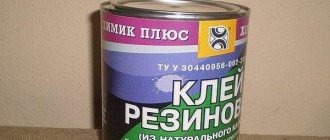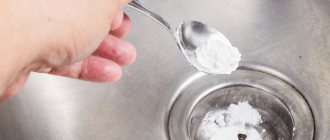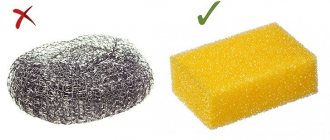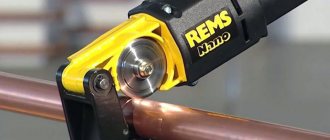How to “drench” a handle with rubber?
Hello.
Tell me, is there a “homemade” way to make a rubber-coated handle for an instrument? Ideally, as I understand it, this is a liquid mastic in which the object is immersed, taken out and hung to dry. Just make sure that there is no bitumen left on your hands later. Is there such a thing? 2ac_52 Yes, among the bourgeoisie, I haven’t seen it among us
If the tool allows some heating, we wrap it in raw rubber, shape it as best we can, vulcanize it, and file it.
Thank you. It's not really a tool
, rather a metal handle. Can this be done at home without starting production? On your knee? In our country ?
If we are talking about a key to a regular cylindrical door lock, then in workshops where duplicate keys are made there are a bunch of multi-colored plastic locks.
Hmm, I missed it in my thoughts: a door lock from a lever lock. About the screw-ups, thank you, I'm aware. One way or another, I will solve the problem, but interest has already arisen: has anyone ever tried my version of the technology? In factories, molds are easily doused with rubber (in my opinion, this was even the method for producing condoms), but at home.
2ac_52 can I dip it in silicone sealant?
ac_52 wrote: How to “cover” the handle with rubber?
Find a rubber palm, drill a hole, and hold the key under the stream.
BV wrote: Find a rubber palm, drill a hole, and hold the key under the stream.
Exactly. I remember reading about this method of making rubber
What about rubber-bitumen anti-gravel from a can (or similar)? There are different fundamentals there.
There is such a bitumen-based waterproofing mastic, I think it’s Technoelast. I don't remember exactly. When dry, it forms a great rubber coating. I was surprised for the first time. You can try it.
2 truten & Hard worker:
Thank you, this is exactly the kind of mastic I was asking about, I just didn’t know the name.
there is a special facilities. in cans like paint. you open the jar, dip the handles of the pliers in there, take them out, they dry out and turn out to be rubber-coated. I don’t know where they sell it, I only saw it in pictures. I do it according to my loctite.
2ac_52 Coat colored ones with acrylic sealant. Use a wet finger to shape the surface.
ac_52 wrote: Hello. Tell me, is there a “homemade” way to make a rubberized handle for an instrument? Ideally, as I understand it, this is a liquid mastic in which the object is immersed, taken out and hung to dry. Just make sure that there is no bitumen left on your hands later. Is there such a thing?
if a non-removable one is suitable, then you can dilute epoxy in a jar, soak cotton wool thoroughly with it, dump this mass into a plastic bag, stick the tool into the mass with the desired end and from above, grasp the cellophane with your hand with a little pressure. The palm print will remain after the epoxy has set and will be very convenient in the future. You can also give it any other shape.
You can also put special rubber or rubber handles on the tool for the handlebars of a sports bicycle. They are wetted in water, stretched and after drying they fit very tightly. cost about 0.5 dollars per handle. if the diameter under the handle needs to be increased, then the electrical tape is wound to the required size.
Source
Rubber coating of shafts, rollers, wheels in Ukraine | UkrPromService
Order a cost estimate Get a consultation In order to place an order, get a consultation or find out the cost of manufacturing rubber, silicone or polyurethane products, leave your contact information, and the manager of the UKRPROMSERVIS company will contact you to clarify the details.
"Ukrpromservice" offers professional rubber coating of shafts with high-quality raw materials. In any production (and in almost any field) there are units whose proper operation is impossible without rubber-coated metal parts. These can be shafts, rollers, drums and much more.
Coating metal with rubber
The main purpose of rubber coating is to protect the metal surface from the destructive influences of the environment. We are talking about both chemical mixtures and simple mechanical friction. Rubber is elastic and resistant to mechanical deformation. In addition, the rubber coating dampens vibration, which reduces the noise level by almost a third.
All together, this speaks of one thing: rubber coating of elements extends the life of the entire structure and significantly increases the efficiency of its operation.
Our company rubberizes metal using several technologies:
- cold vulcanization;
- hot vulcanization;
- bolted plates.
To order products or get advice
The Ukrpromservice team does not stand still. We constantly study the latest technical developments in terms of rubber goods and ourselves create original mixtures of high-strength rubber based on imported rubber of excellent quality. In addition, for higher adhesive properties, our specialists use high-quality foreign adhesive mixtures.
Rubber coating of transport roll trailer wheels
It’s hard to imagine the warehouse space of any large enterprise without a roll-trailer. The presence of these trolleys allows you to reduce the total amount of tractors involved in the process and at the same time transport a significant amount of cargo.
The only drawback of such equipment is the wheels - this is the least durable part of the structure. In addition, in terminal premises the floor surface is rarely ideal, so rubber coating of roller trailer wheels is an urgent need.
Elastic rubber will soften the movement of the structure and protect the trailer from wheel or axle breakage, and workers from excessive noise.
Ukrpromservice specialists have extensive experience in rubberizing wheels of roller trailers. We can carry out rubber coating by hot vulcanization. In this case, the elements that need to be covered with rubber will need to be delivered to our factory.
In addition, if necessary, our team will quickly bring your equipment into working condition right in your warehouse. Using imported adhesive mixtures and rubber plates of our own production, the professional service group Ukrpromservice will rubberize the wheels of a roll trailer, practically without interrupting production.
Rubber coating of rollers of various conveyor systems
For the smooth movement of any conveyor belt, the coordinated operation of all its parts is important. To achieve maximum efficiency, parts of the unit such as rollers, drums, etc. are rubberized. Thanks to the natural properties of rubber, wear of parts is slowed down, and controlling the speed of the belt in a straight line becomes much easier.
In addition, self-cleaning plates prevent material build-up, reducing stress and increasing productivity.
Rubber coating of rollers can be done by vulcanization in an autoclave on the territory of our plant. This method is considered one of the most durable and is called hot vulcanization. The only negative is the need for processing strictly on the technical base of Ukrpromservice and a longer rubber coating period.
How to rubberize metal with your own hands? A simple, fast and most importantly cheap way!
Many of you have encountered the problem of unwanted sliding of objects on a metal or any other similar surface. And such surfaces are cold and unpleasant to the touch. In our article we will tell you how to rubberize metal with your own hands. This method does not require much physical effort or financial costs, and it is suitable for almost any other surfaces that do not react to silicone. Are you interested? Then read on.
How to glue rubber to metal: instructions for use
First you need to clean the gluing areas from dirt and clean the painted base. The second stage of preparation is degreasing, which increases adhesion. Then you will need to do the following:
- lubricate both parts with a thin layer of adhesive mass (approximately 2 mm);
- Place the parts tightly together and hold until the glue hardens (you can use a vice or a press);
- Sand off the protruding frozen mass with sandpaper or cut it off.
It is advisable to start using the glued item no earlier than one day after the repair.
Materials for work
In order to rubberize metal , you will need:
Step 1. Prepare the surface
Degrease the surface to be coated with rubber using any degreaser.
If the surface is susceptible to corrosion, apply a layer of special primer to it.
After the primer has dried, cover the surface with a reinforcing mesh.
Cover the border of the future rubberized layer with masking tape.
Step 2. Rubberize the surface
Using a spatula, smooth out the silicone layer.
If necessary, carry out similar operations on the other side of the surface.
Dry the surface with a hairdryer.
We repeat the process of applying silicone, leveling it and drying it until the silicone completely covers the reinforced mesh.
We apply a little more silicone and use a foam sponge to give it a beautiful matte structure using dipping movements.
After the silicone has completely dried, cut it and remove the masking tape. The result is such a beautiful and pleasant-to-touch layer.
Do-it-yourself rubber coating
How to rubberize metal with your own hands? A simple, fast and most importantly cheap way!
Source
Non-metallic protective coatings
Non-metallic protective coatings are used to insulate metal products, protect them from the effects of the external environment (moisture), and give them a beautiful appearance.
Non-metallic protective coatings are usually divided into paints, polymers, rubber coatings, lubricants, silicate enamels, and pastes.
Paint and varnish protective coatings.
Paint and varnish protective coatings are widespread and used most often. The coating composition includes film-forming substances, fillers, pigments, plasticizers, solvents, and catalysts. This type of coating not only protects the product well in various environments, but also gives it a pleasant appearance. In addition, by varying the composition and materials used, coatings with specific properties are obtained (conductive, antifouling, luminous, decorative, with increased strength, heat resistance, acid resistance, etc.).
Paint and varnish protective coatings, in turn, are divided into varnishes, paints, enamels, primers, drying oils and putties.
Polymer protective coatings.
Polymer protective coatings are applied to the surface of a product in the form of hot resin to protect it from the external environment. Coating with resin can be carried out by dipping, thermal or vortex spraying, or with a regular brush. After cooling, a protective continuous film of polymer is formed on the surface, usually a couple of millimeters thick.
The most common polymers used for corrosion protection are: polystyrene, polyethylene, polypropylene, polyisobutylene, fluoroplastic, epoxy resins, etc.
Polymer protective coatings can be used as linings for chemical devices and tanks.
Protective coating with rubber (gumming).
Protective coating with rubber (gumming) is carried out with rubber and ebonite to protect various containers, pipelines, tanks, chemical apparatus, tanks for the transportation and storage of chemicals from the effects of the external environment. The protective coating can be formed from soft (when the product in use is exposed to shock, tensile, oscillatory and other types of loads) or hard rubber (which operate at a constant temperature and are not subject to loads). The softness of rubber is controlled by sulfur additives. Soft contains from 2 to 4% sulfur, and hard - 30 - 50%. To obtain a durable protective coating, both rubber and ebonite are often used.
Rubber is applied to a previously cleaned and degreased surface, first treating it with rubber glue, then squeezing out the accumulated air with a roller. The final stage in gumming is vulcanization.
Rubber protective coatings are good dielectrics and are highly resistant to many acids and alkalis. Only strong oxidizing agents have a destructive effect on rubber coatings. Rubber coatings, like all polymer materials, have the negative property of aging over time.
Protective coatings with silicate enamels.
Protective coatings with silicate enamels are used for products operating at high temperatures, pressures, and in very aggressive, chemically active environments. The formation of an enamel protective coating is possible in two ways: dry (apply powder) or wet (paste).
How to rubberize metal with your own hands? A simple, fast and most importantly cheap way!
Many of you have encountered the problem of unwanted sliding of objects on a metal or any other similar surface. And such surfaces are cold and unpleasant to the touch. In our article we will tell you how to rubberize metal with your own hands. This method does not require much physical effort or financial costs, and it is suitable for almost any other surfaces that do not react to silicone. Are you interested? Then read on.
Safety precautions when working with glue
The adhesive mass contains various components that evaporate during the polymerization process, leaving a strong, durable seam. Therefore, when working with adhesives, you must follow the following safety rules:
- Carry out gluing in a well-ventilated area.
- Use protective equipment (gloves, goggles, respirator). In case of contact with skin or eyes, immediately rinse the affected area under running water.
- To apply the adhesive in doses, use a dispenser tube, brush or spatula. Place items stained with glue on a special stand, and immediately close the tube with a lid.
Adhesives for bonding rubber to metal substrates may contain substances that irritate the respiratory tract and can cause eye burns or burning of the skin.
If during work the mass gets into exposed areas of the body and your health worsens, you should urgently seek medical help.
Materials for work
In order to rubberize metal , you will need:
Step 1. Prepare the surface
Degrease the surface to be coated with rubber using any degreaser.
If the surface is susceptible to corrosion, apply a layer of special primer to it.
After the primer has dried, cover the surface with a reinforcing mesh.
Cover the border of the future rubberized layer with masking tape.
Step 2. Rubberize the surface
Using a spatula, smooth out the silicone layer.
If necessary, carry out similar operations on the other side of the surface.
Dry the surface with a hairdryer.
We repeat the process of applying silicone, leveling it and drying it until the silicone completely covers the reinforced mesh.
We apply a little more silicone and use a foam sponge to give it a beautiful matte structure using dipping movements.
After the silicone has completely dried, cut it and remove the masking tape. The result is such a beautiful and pleasant-to-touch layer.
Do-it-yourself rubber coating
How to rubberize metal with your own hands? A simple, fast and most importantly cheap way!
Areas of use
Gumming of metal is widely used for protective coatings in all industrial fields. This method is used to treat the internal space of containers and reservoirs, and to apply it to columns, centrifuges, pipelines, mixers, and stirrers. Before coating, corners are rounded, shells, chips, and cracks are removed. Rubber sheets are glued with special adhesives to a thoroughly cleaned, degreased surface.
Next comes the vulcanization process. The rubber coating is kept at a temperature of 130ºС for 15…25 hours. Vulcanize in autoclaves with water vapor at a pressure of 2.5...3 atm. The internal surfaces of large units are vulcanized with hot air or a salt solution at a temperature of 105...110ºС.











